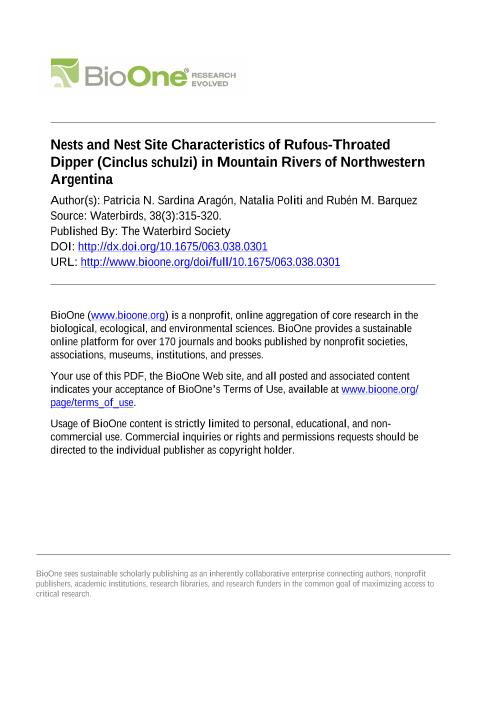Mostrar el registro sencillo del ítem
dc.contributor.author
Sardina Aragon, Patricia Noemi

dc.contributor.author
Politi, Natalia

dc.contributor.author
Barquez, Ruben Marcos

dc.date.available
2018-04-16T20:58:08Z
dc.date.issued
2015-09
dc.identifier.citation
Sardina Aragon, Patricia Noemi; Politi, Natalia; Barquez, Ruben Marcos; Nests and Nest Site Characteristics of Rufous-Throated Dipper (Cinclus schulzi) in Mountain Rivers of Northwestern Argentina; Waterbird Society; Waterbirds; 38; 3; 9-2015; 315-320
dc.identifier.issn
1524-4695
dc.identifier.uri
http://hdl.handle.net/11336/42212
dc.description.abstract
The Rufous-throated Dipper (Cinclus schulzi) is an endemic and threatened bird that inhabits the mountain rivers of southern Yungas of Argentina and Bolivia. This is the rarest and least known species of the genus, in part because of its restricted distribution. The aim of this study was to describe the nests and nest sites of the Rufous-throated Dipper in mountain rivers of northwestern Argentina. Five rivers were surveyed in transects of 3 to 6 km long from 2010 to 2013. The shape, size, substrate and building material of nests and nest and non-nest characteristics were assessed and compared in plots of 2 by 2 m. Plots with nests were compared to non-nesting plots for a number of habitat characteristics. Most nests found (78.57%; n = 28) had a globular shape, were attached to rocky substrates and were built using moss. The height of nests above the water level (P = 0.02), slope (P = 0.03) and watercourse width (P < 0.01) varied among rivers. Plots at nest sites had significantly higher values of some habitat characteristics than non-nesting plots, including emergent rocks (P < 0.01), slope (P < 0.02), greater number of rapids (P < 0.01), number of pools (P < 0.01), water velocity (P < 0.05), and river depth (P < 0.01), but had narrower watercourse width (P < 0.01). Previously, the understanding of the breeding ecology of the Rufous-throated Dipper was based only on anecdotal evidence. Understanding the breeding habitat requirements is a prerequisite for the development of a conservation action plan for this threatened species.
dc.format
application/pdf
dc.language.iso
eng
dc.publisher
Waterbird Society

dc.rights
info:eu-repo/semantics/openAccess
dc.rights.uri
https://creativecommons.org/licenses/by-nc-sa/2.5/ar/
dc.subject
Breeding Biology
dc.subject
Breeding Habitat
dc.subject
Conservation
dc.subject
Watershed
dc.subject.classification
Otras Ciencias Biológicas

dc.subject.classification
Ciencias Biológicas

dc.subject.classification
CIENCIAS NATURALES Y EXACTAS

dc.title
Nests and Nest Site Characteristics of Rufous-Throated Dipper (Cinclus schulzi) in Mountain Rivers of Northwestern Argentina
dc.type
info:eu-repo/semantics/article
dc.type
info:ar-repo/semantics/artículo
dc.type
info:eu-repo/semantics/publishedVersion
dc.date.updated
2018-04-12T14:32:51Z
dc.identifier.eissn
1938-5390
dc.journal.volume
38
dc.journal.number
3
dc.journal.pagination
315-320
dc.journal.pais
Estados Unidos

dc.description.fil
Fil: Sardina Aragon, Patricia Noemi. Universidad Nacional de Tucumán. Facultad de Ciencias Naturales e Instituto Miguel Lillo. Programa de Investigación de Biodiversidad Argentina; Argentina. Consejo Nacional de Investigaciones Científicas y Técnicas; Argentina
dc.description.fil
Fil: Politi, Natalia. Universidad Nacional de Jujuy. Facultad de Ciencias Agrarias. Cátedra de Desarrollo Sustentable y Biodiversidad; Argentina. Consejo Nacional de Investigaciones Científicas y Técnicas; Argentina
dc.description.fil
Fil: Barquez, Ruben Marcos. Universidad Nacional de Tucumán. Facultad de Ciencias Naturales e Instituto Miguel Lillo. Programa de Investigación de Biodiversidad Argentina; Argentina. Consejo Nacional de Investigaciones Científicas y Técnicas; Argentina
dc.journal.title
Waterbirds

dc.relation.alternativeid
info:eu-repo/semantics/altIdentifier/doi/http://dx.doi.org/10.1675/063.038.0301
dc.relation.alternativeid
info:eu-repo/semantics/altIdentifier/url/http://www.bioone.org/doi/10.1675/063.038.0301
Archivos asociados
